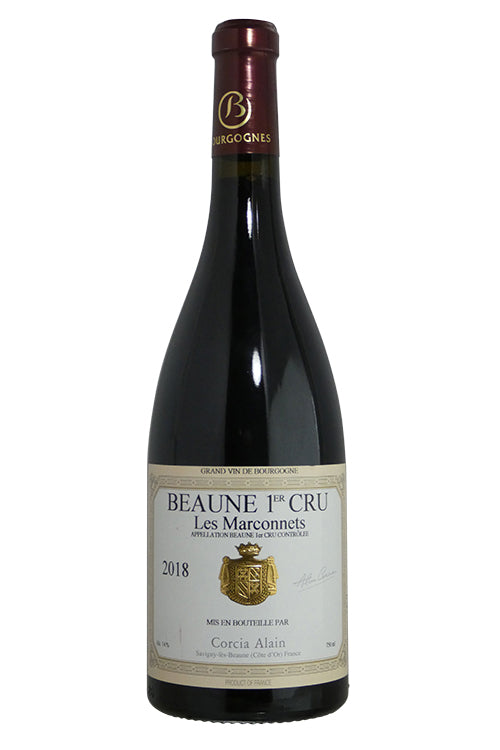1
/
of
1
Alain Corcia Beaune 1er cru les Marconnets - 2018 (750ml)
Alain Corcia Beaune 1er cru les Marconnets - 2018 (750ml)
Regular price
$49.99
Sale price
$49.99
Regular price
$64.99
Unit price
/
per
Juicy greengage veers into ripe Mirabelle and lemon on the nose of this wine. On the concentrated palate the smokiness and phenolic edge of oak comes through, adding texture to the mouthfeel. This wine captures the ripeness of 2018 with its warmth and fruit, but counters it with freshness. ANNE KREBIEHL MW
Wine Enthusiast - 92 points
Wine Enthusiast - 92 points
Share :

- varietal
- Region
- Sub - Region
- Type
- Reviews
Product Review
Juicy greengage veers into ripe Mirabelle and lemon on the nose of this wine. On the concentrated palate the smokiness and phenolic edge of oak comes through, adding texture to the mouthfeel. This wine captures the ripeness of 2018 with its warmth and fruit, but counters it with freshness. ANNE KREBIEHL MW
Product Score
92
Pinot Noir is responsible for some of the worldâ??s finest wines. Famed for producing the red wines of Burgundy and the C?´te dâ??Or in particular, it is now widely grown in cool climates across Califonia and Oregon, and with increasing success in New Zealand. Although typically used to produce varietal wines, Pinot Noir makes a significant contribution in the wines of Champagne, where it is vinified as a white wine and blended with Cardonnay and Pinot Meunier. On the whole, fresh summer fruit of strawberries, raspberries and red cherries tend to be the identifying qualities, however richer versions express darker fruit including black cherries (kirsch), cherry cola, leather and violets to name a few.
Two hundred miles south east of Paris lies the famous and historic wine region, known in French as Bourgogne. The Cote d'Or, the heartland of the region, consists of two distinct sub-regions split on either side of the town of Beaune.The C?´te de Nuits to the north, includes the famous villages of Vosne-Romanee, Gevrey-Chambertin, and Nuits-Saint-Georges and are known primarily for making red wine from Pinot Noir.Although The C?´te de Beaune to the south still makes some magnificent reds (see Volnay and Pommard), white wine made from Chardonnay is the main focus. The most famous villages are Puligny-Montrachet and Meursault. Burgundy has three other important regions. The village of Chablis (exclusively Chardonnay) encompassing the region's most northerly vineyards. The C?´te Chalonnaise and M??connais to south are quantitatively speaking more important. Agriculture is more diverse with a significant portion of the land devoted to livestock and arable farming.
Beaune is the center of Burgundyâ??s wine production, where most of the regionâ??s negociants, such as Champy, Joseph Drouhin, Louis Jadot, and Louis Latour, were founded and continue to operate. The townâ??s name is also given to the Cote de Beaune district, which, with the Cote de Nuits, completes the whole of the Cote dâ??Or. Its wines are mainly red, and although more varied, are somewhere in the middle between Pommardâ??s richness and Volnayâ??s fragrant and elegant qualities. With a whopping forty-four premier cru vineyards, nearly three quarters of the total vineyard area is premier cru. While the finest vineyards are said to be those northwest of the town, climbing up the hill of Les Mondes Rondes, such as Les Greves and adjoining Les Bressandes. Clos du Roi and Blanche Fleurs in the northeast also perform consistently, as do the likes of Clos-des-Mouche bordering Pommard at the opposite end. In fact, of the little white wine made (about 6%) Drouhinâ??s Clos-des-Mouche is one of the most expressive and age-worthy.
Red wine is wine made from dark-coloured grape varieties. The color of red differs based on the grapes variety or varieties used.Interestingly, black grapes yield a juice that is greenish-white. The actual red color comes from anthocyan pigments (also called anthocyanins) from the skin of the grape (exceptions are the relatively uncommon teinturier varieties, which produce a red colored juice). Most of the production centers around the extraction of color and flavor from the grape skin.


